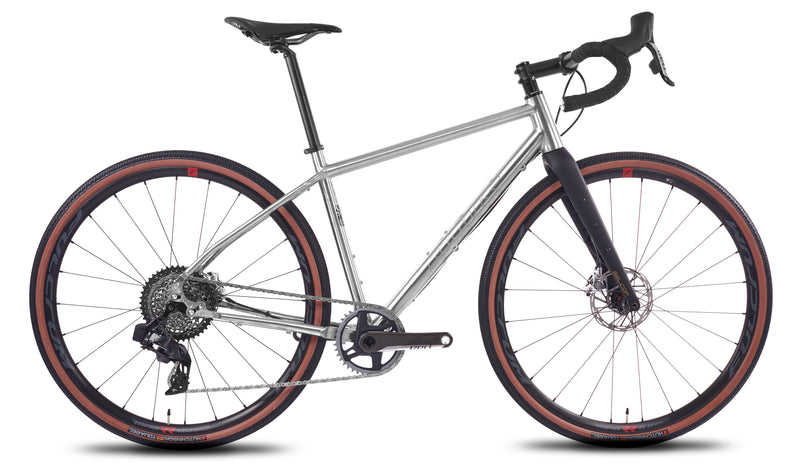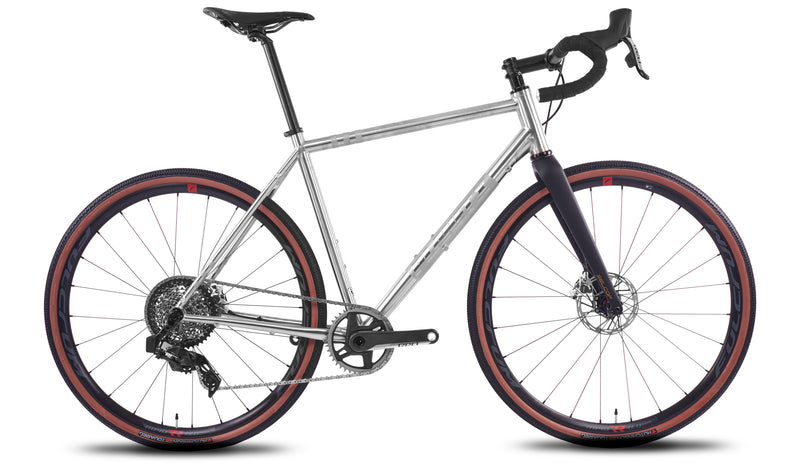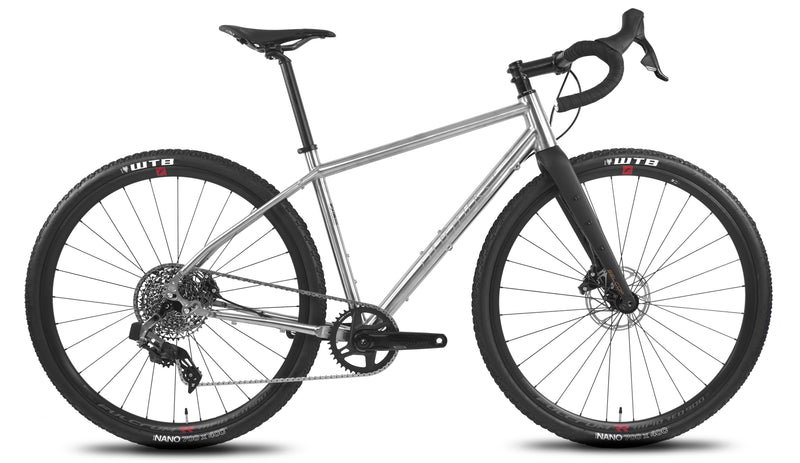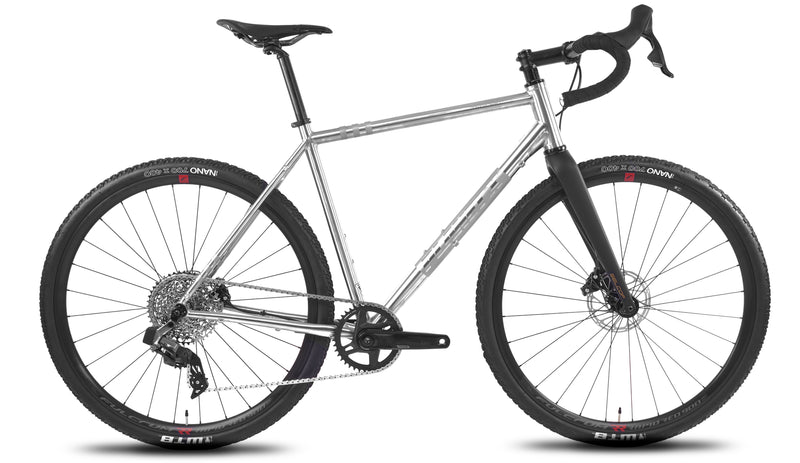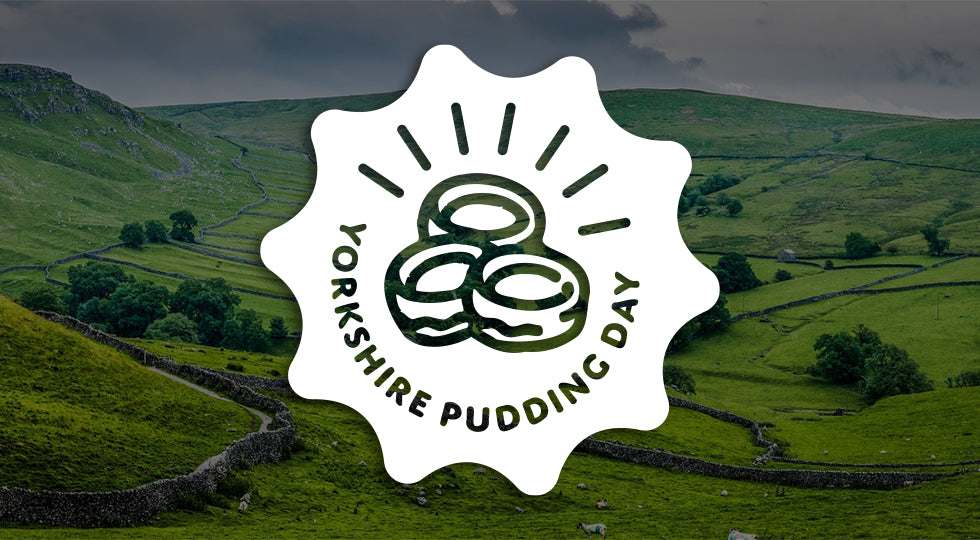Gravel Bike Buying Guide: What Is A Gravel Bike?
10 January 2024
What is a gravel bike?
A gravel bike is essentially a drop-bar bike that has been designed to be as capable on the road as it is off-road.
Gravel bikes have become massively popular in recent years probably due to their versatility and the different riding opportunities they offer.
Long distance comfort is the aim of most gravel bikes, encouraging a style of riding that is more endurance and exploration than flat out speed.
They feature powerful disc brakes, frame clearance for large off-road style tyres and have geometry that gives the rider a more upright position to help with stability on rough terrain.
What is a gravel bike used for?
The benefit of gravel riding is that you have the option of riding on a variety of surfaces, opening up your cycling route and allowing you to explore more.
The relaxed geometry featured on gravel bikes promotes extra comfort over long rides as well as being more solid when it comes to technical terrain.
Although gravel bikes may look similar to road bikes and perform extremely well when riding on the road you can venture off onto dirt and gravel tracks whenever you like, giving these bikes the title of the do-it-all adventure bike.
Why are gravel bikes so popular?
1. Versatility
2. Great for beginners
3. Growing number of gravel races
Did you know that there are competitive gravel biking races held around the UK? These races combine the challenges of mountain biking and road cycling to test your abilities - not to mention making for a great day out. You can even give cyclocross a go - a winter cycling sport that meshes riding a bike with navigating an obstacle course. Having a gravel bike to hand can broaden your horizons, opening you up to these new opportunities you couldn’t take with a road or mountain bike alone.
4. Growing popularity of bikepacking
Finally, there’s one type of bike ride that really wouldn’t be nearly as good if taken on a mountain bike or a road bike. Bikepacking is the ultimate cycling holiday. You can tour a city, region or even a whole country while enjoying the perks of a leisurely bike ride along the way. Whether you prefer to stay in a bed and breakfast or camp out under the stars, bikepacking is best with a gravel bike. It will take you off the beaten track so you can explore the wild and wonderful sights to be seen away from the driveable paths.
With a less aggressive riding position than a road bike, gravel bikes are designed for maximum comfort in the saddle on longer rides. They also have additional luggage mounting points to help you carry everything you need for the trip. In fact, with a gravel bike, the world is your oyster.
What makes a good gravel bike?
Once you’ve decided which type of bike you want, there will still be some variation between different models and brands. Which one you go for is down to personal preference in many cases, although performance considerations will also come into play. For example, if you’re looking to race on your gravel bike, opting for one with a carbon frame and fork can help you to shed weight for better acceleration.
Another thing to think about is whether you prefer flat handlebars or drop bars. Flat handlebars may be best if you’re used to mountain bikes, however drop bars may be more appropriate for longer distances. If you’re looking to get started with bikepacking or you’re already a fan, drop handlebars may be more comfortable, allowing you to change your hand position at regular intervals during your ride.
Gravel bike geometry
At first glance, a gravel bike's frame and fork may look just like a road bike's. The difference is they are carefully designed with off-road stability at the core.
Areas where you will be able to see these design differences are in the slacker angles of the frame and fork, making the bike longer.
This slacker geometry also naturally encourages a more upright position on the bike, which is good for long days in the saddle and off-road exploration.
Gravel bike tyres
Tyre volume and tread are key indicators when identifying a gravel bike.
You can easily distinguish between road and gravel bikes by their tyres.
Gravel bikes have wide chunky tyres (up to 40mm) and feature a grippy tread pattern. The size lets you run lower pressures and this helps cushion the ride when things get bumpy as well as aiding with traction and control.
Gravel tyres can range from the more dirt-focussed, off-road kind, featuring aggressive tread patterns and large lugs, to more smoother tyres with minimal tread that look more like fat road tyres.
A popular choice is the middle ground tyre combining a low-profile centreline, for speed on the road, with traction boosting outer knobs, for when things get rowdy.
Gravel Bike vs. Road Bikes
Although the terrain you might be riding on a gravel bike could be described as aggressive, the geometry of a gravel bike when compared to a road bike is much less aggressive. What this means is, unlike the tight, disciplined angles seen on road bikes to promote a tucked down, aerodynamic position, a gravel bike's upright and relaxed positioning gives improved stability and off-road control as well as being more comfortable.
As mentioned before, gravel bikes feature much more tyre clearance than road bikes, capable of housing wide tyres with extra grippy tread, opposed to the super thin and slick tyres on road bikes.
This said a good gravel bike won't feel that much different when on tarmac but as we've covered already, getting off-road is when gravel bikes truly shine!
So there you have it, Gravel bikes combine the best features and functionality of both road and mountain bikes into the form of incredibly versatile and well equipped do-it-all adventure machines. These are probably the most versatile bikes you can buy and they are capable of tackling any towpath, track, trail or tour route that you can think of.
There's an adventure waiting for you every time you throw a leg over a gravel bike.
Should I buy a gravel bike?
Thinking of buying a gravel bike? Getting the right bike is important no matter what type of riding you enjoy, and gravel adventure riding is no exception. To help you make the most appropriate choice, we’ve put together this article outlining the best reasons to get a gravel bike, what you should look out for when buying one, and a few pointers to decide if a gravel bike is right for you.
Why a gravel bike?
To answer that question, we first have to address the question of what a gravel bike is. Often referred to as a bike that features the best of both road and mountain bikes, gravel adventure bikes are where the two separate disciplines overlap. Gravel bikes are hardy enough to take on rougher terrains than road bikes can, but they’re also better suited to road cycling than mountain bikes.
So why buy a gravel bike rather than a road or mountain bike? Well, if you’re a cyclist who’s keen on both types of riding, getting one gravel bike is a cheaper alternative to getting a road bike and a mountain bike. If you’re not overly concerned with having the very best performance in each separate discipline, a gravel bike will do you well both on and off the road.
Gravel bikes also make great starter bikes for anyone who’s not sure which type of cycling they prefer yet. They represent a lower risk investment for newbies - if, for example, you discover road cycling isn’t for you, you’ve still got a great bit of kit that can handle many mountain biking trails, and vice versa.
And if you’re a racer, don’t be fooled into thinking that there are no events out there for a gravel cyclist. Gravel biking has swiftly become massively popular, with a range of gravel-specific races popping up all over the world. While it may not be as popular yet as road or mountain biking, it’s getting closer all the time.
What makes a good gravel bike?
Choosing the right gravel bike for your needs isn’t as simple as identifying what features make a gravel bike great. Because they’re so versatile, gravel bikes are good for pretty much anything, but that hasn’t stopped manufacturers from releasing new models that are tailored towards different points on the road to mountain biking scale. In other words, not all gravel bikes are made the same - and some may be better suited to your purposes than others.
If you’re a racer who favours road cycling, you’ll want to aim for a gravel bike with an aggressive riding position that allows you to reach a similar level of aerodynamic streamlining as you would on a road bike. You’ll also want to shave off the weight wherever you can, so remember to ride light and forego the racks and packs.
If you’d rather lean towards the off-roading side of things, you’ll want a frameset that allows for plenty of tyre clearance so you can fit your gravel bike with wide tyres for added stability. A suspension fork can also be very helpful for rougher terrains, and durable components are a must.
Alternatively, if you’re more of a casual, jack-of-all-trades cyclist, or you prefer commuting or leisurely rides, you can find a gravel bike to fit those needs too. For this kind of cycling, opt for a bike with an upright, comfortable riding position and maximise comfort wherever possible. Another feature to consider is the bike’s mounting points - perfect for loading up with bikepacking bags, storage racks and water bottles to keep you going.
Do I need a gravel bike?
It can be hard to decide whether or not a gravel bike is the right choice for you, especially if you mostly do one kind of cycling or the other. After all, a road bike isn’t that different from a gravel bike, right?
Wrong. Although they can look similar, gravel bikes have different geometry and different components. This makes them better suited to the rougher terrains that a road bike shouldn’t attempt.
While a road bike might just about be able to handle certain off-road trails, it’s best not to push the limits of what is safe. When bikes are tested, those tests are carried out for the expected conditions of usage - which means your trusty road bike probably hasn’t been assessed for its handling of gravel or mountain bike trails.
In short, pick a bike that’s suited to the discipline you want to pursue. If you’re into road cycling, choosing a high quality road bike will help you to achieve the best performance in a race scenario. Similarly, a top of the range mountain bike is a good idea if you’re looking to tackle the most challenging trails available. But if you’re somewhere in the middle, a gravel bike is sure to do you proud.
When shouldn’t you choose a gravel bike?
Gravel bikes are pretty impressive, but while they’re good for a wide range of routes and terrains, there are nevertheless some situations where you’d be better off choosing a road or mountain bike instead.
While a gravel bike is perfectly fine for road cycling in a casual environment, chances are you’ll need a road bike if you intend to race competitively. Road cycling races tend to have rules on various components that limit the range of bikes you can compete on - which means a road bike is almost always required. On top of these rules, you’ll probably find you perform better in a road race on a road bike anyway - after all, it is what they’re made for. Road bikes tend to be lighter, more aerodynamic and feature a more aggressive riding position in order to help you cycle as fast as you possibly can in race conditions.
Similarly, if you’re looking to enter a competitive mountain biking race, it’s probably best to stick to a mountain bike. Gravel bikes can take on the average mellow cross-country trail, but when it comes to those hardcore MTB tracks that really put your skills to the test, mountain bikes are simply better adapted to get the job done.
